 Open Access
Open Access
EDITORIAL
Foreword International Conference on Materials and Energy (ICOME 2021)
1 Université de Lorraine–Institut Henri Poincaré de Longwy (IUT), Longwy, France
2 Université Paris-Saclay, ENS Paris-Saclay, CNRS, LMPS, Gif-sur-Yvette, France
3 Académie Hassan II des Sciences et Techniques, Rabat, Morocco
4 Université de Lorraine–Institut Hubert Curien d’Epinal (IUT), Epinal, France
* Corresponding Author: El Ganaoui Mohammed. Email:
(This article belongs to the Special Issue: Materials and Energy an Updated Image for 2021)
Fluid Dynamics & Materials Processing 2023, 19(8), 2131-2146. https://doi.org/10.32604/fdmp.2023.027329
Received 31 March 2022; Accepted 24 October 2022; Issue published 04 April 2023
Abstract
The International Conference on Materials and Energy (ICOME) was held in Metz on June 2021 following the earlier successful conferences of the same series held in Tunisia in 2019, Spain in 2018, China in 2017, France in 2016 and Morocco in 2015. The 2021 event should be regarded as a late realization of the ICOME 2020 conferences, which had to be delayed due to the pandemic. A significant number of papers presented in the framework of this conference have been selected for publication in the Fluid Dynamics and Material Processing international peer reviewed Journal given the relevance of the treated subjects to the aims and scope of this journal and the high quality of these contributions. This foreword provides a critical review of the 2021 conference aims in relation to its potential impact on the fields of Materials and Energy and related societal benefits.Keywords
Foreword
The global health crisis of COVID-19 has shown more than even that the eyes of the citizens are turned towards science in order to bring very quickly palliative and then decisive solutions to the pandemic. In such a situation threatening the human species, the prerogative of science would like researchers to work together in a spirit of sharing information, methods, and discoveries, simply working for the sustainability of man and life in general when it is threatened. Although the situation prevented any face-to-face meetings, the exchanges continued.
Indeed, the evolution of knowledge during the last two centuries allows today, thanks to the development of virtual interfaces and to the progress of the algorithmic, to transport sound and visual information, which tend to generalize to the sensory. No one knows the limit of this exercise. In an increasingly reliable, stable, and fast way, this connection made possible continuity of the pedagogical transmission and scientific research. This is another demonstration that the knowledge produced, accumulated, and preserved is today a kind of life-saving arch for doctors and patients, litigators and judges, teachers and students, professors and doctoral students, to continue to advise, assist, dialogue, transmit and create the knowledge of tomorrow. In this sense, the high places of knowledge that are the Universities, the Academies of Sciences, and the schools have largely fulfilled their saving missions towards the whole of humanity.
In mathematics, if the extraction of the square root of a number became a children’s game with the advent of calculators, its extraction with a sheet of paper, a pencil, and the four elementary operations was before, an exercise that can be long. Similarly, for prehistoric person, bringing a quantity of water to a boil without having a metal container, although the domination of fire was in the same order of challenge as extracting the root of a number without a calculator.
Firstly computers worked with lamps; today’s computers (for all purposes) are based on the use of transistors industrialized since 1950, and their design is closely linked to the advent of rare earth metals. By chance, Moore’s law (doubling every eighteen months of the density of transistors in processors every year) sees its predictions come true in the challenge of materials. This law is accompanied in a global context by another law called the Dennard law (increase in computing power at constant energy), which opens the energy efficiency challenge. Without these two competitions between materials and energy (involving many scientific disciplines), the reader is free to imagine what his daily life would have been like during the lockdowns that have disrupted the existence of the world’s citizens since the end of 2019.
In this spirit, the ICOME (International Conference of Materials & Energy) tends to bring an updated and balanced picture of advances in the fields of materials and energy annually and address significant progress in both fundamental and applied research as well as in societal areas.
This virtuous loop has punctuated the history of humanity by taking advantage of all the advances in knowledge as a natural laboratory or as a crucible providing innovations and allowing experimental physics and numerical mathematics to continue their breakthroughs. Among these breakthroughs, we will particularly note those in optoelectronics, laser physics or high-performance computing.
The ICOME 2020 edition was planned to take place in Metz, in Lorraine, and would address advances in the fields of materials and energy. This edition was to take place under the auspices and legacy of the mathematician Henri Poincaré (Nancy) and the poet Paul Verlaine (Metz), what a symbol of science and society. This conference returns after an international tour in Africa and Asia, especially after the success of the 2019 edition in Tunisia. ICOME is also a bridge between the two shores of the Mediterranean, the crucible of a civilization that has largely influenced, in its own way, the course of the history of materials and energy.
We are particularly grateful to the international speakers willing to come in 2020 and reiterated their solidarity with this online edition. Our gratitude also goes to the organizers of the mini-symposia. All authors and contributors have coped and maintained their interest in the event, we hope to live up to their expectations.
Usually, the conference is coupled with a thematic school for Ph.D. students and young doctors. It is a privileged place of exchange between juniors and seniors who take advantage of the event’s atmosphere to benefit from the seniors’ advice and experience. Only face-to-face exchanges can ensure and fully consolidate the benefits of the seniors’ values. The committee has chosen to reschedule the theme school for a face-to-face event during the autumn of 2021 (Fig. 1), if pandemic conditions allow for travel and regrouping.

Figure 1: ICOME 2021–Topical School Consecrated to Climate Change with G. Levermore–D. Raynaud two GIEC Member and Co-Laureates of the Nobel Prize 2007 (We have to harry up with climate change)
We have the great pleasure of having an opening session by very highlighting scientific personalities, the perpetual secretary of Academy Hassan II Sciences and Technics, the president of Lorraine University, the ICOME chairs, and a Green European Parliament Deputy author of a review on Hydrogen Energy [Appendix].
During this edition of ICOME 2020 & 2021, participants worked three days of intense activity, through twelve plenary lectures given by renowned scientists [Appendixes 2–12]. Three mini-symposia [Appendixes 13,14] dedicated to current topics such as photonics applied to materials for energy, matter sciences in microgravity, or innovative simulation approaches such as Boltzmann network methods.
The topic of climate change has largely shown its importance for the planet’s future. This theme is at the crossroads of science and the organization of our societies. It is not far from the problems of materials and energy. We will leave it to each one to imagine these links. Professor G. Levermore from the University of Manchester, the member of the 2007 Nobel Peace Prize team of the Intergovernmental Organization for Climate Change, has given us the honor and pleasure to talk about climate change in the opening conference.
The series of lectures on materials and energy promotes initiatives and values science as a vector of accumulation of human progress, cultural exchange, the economy of mind, sharing and investment in intelligence, the strength of argument, the guarantee of respect for opinions, initiator of creativity, support for the quest for truth. In this sense, the nod to the universal scientist Averroès, born in Cordoba in Spain in 1126 and died in Marrakech, Morocco in 1198, through the price bearing his name reinforces this vision of a man who places truth beyond the beliefs and allegiances of his time, intelligence beyond temporal interest and societal use.
“Knowledge acquired in a foreign country can be a homeland, and ignorance can be an exile lived in one’s own country” Averroès (1126–1198).
The organizers of the ICOME 2020–2021 edition wish everyone a fruitful event where young researchers can deepen their knowledge online while waiting for better days.
The organizers would like to thank the entities that supported the event, particularly the laboratories and institutes of the University of Lorraine that encouraged and supported the holding of this edition in Lorraine and accompanied the ICOME series since its creation. Particularly entities which allowed publication of papers in Fluid Dynamics and Material Process international journal (FDMP) (Fig. 2).

Figure 2: Entities that allowed publication of papers in Fluid Dynamics and Material Process international journal (FDMP)
ICOME Serie’s Spirit
The ICOME series and school is an initiative of Paris Saclay (ENS Cachan) and the University of Lorraine (Institut Henri Poincaré of Longwy). Prof. R. Bennacer (UPS) and Prof. M. El Ganaoui (UL), after a large concertation highlighting international personalities and actively acting in existing Int. Serie’s (JITH, ICTEA, CHT, ICCHMT, ICCREMA, CFM, ...)1 in 2013–2015 operated to create and to chair a new series both operating on Material Sciences and Energy. The project aims to interlink the two communities dealing with either the materials used in order to produce/reduce the energy demand or the energy used to produce new materials and the related life quality. The goal is to let communication between these two sub-domains allow interlinked projects. Consequently, discipline as heat transfer, fluid mechanics, and automatics acting on energy-applied materials and vice versa will be developed in the hospices of ICOME.
Indeed the first International Conference on Materials & Energy (ICOME 2015) held in the nice Mediterranean city Martial-Tetouan in Morocco, followed by the edition of 2016 in the beautiful Atlantic city of La Rochelle in France, the edition 2017 in the amazing Eastern part of China at Tianjin, ICOME 2018 in the sunny coastal city Donostia-San Sebastian located at the North of Spain, ICOME 2019 in the sweet city of Hammamet in Tunisia and back to France ICOME 2021 in this present successful online edition.
The Guest editors of the present issue are Pr. R. Bennacer, Pr. M. El Ganaoui, Dr. K. Ragui, and Dr. S. Morsli.
In the following, a summary is provided of the keynote/invited lectures delivered in the frame of this conference together with a short biography of the invited speakers.
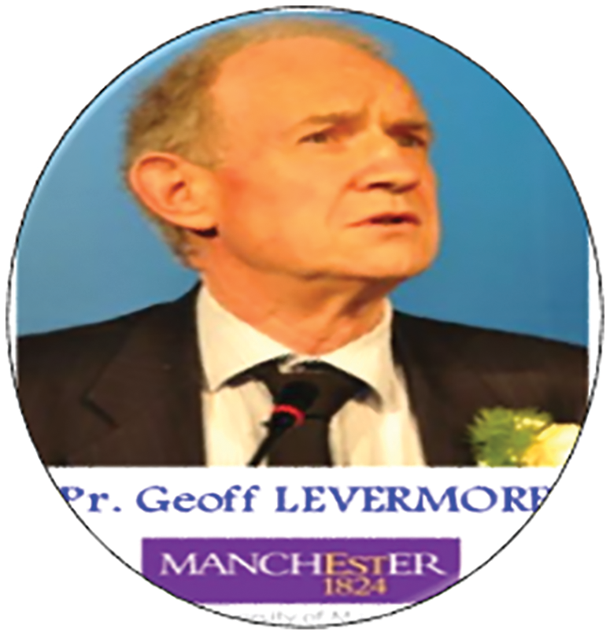
Keynote/Invited Lecturer during ICOME 2021
Topic: Climate Change and Materials for Mitigation and Adaptation.
By: Prof. Geoffrey Levermore, Manchester University, United Kingdom.
The presentation starts by looking at climate change and global warming evidence. It highlights the carbon 12 carbon 13 ratio as evidence of humankind’s fossil fuel emissions into the atmosphere. The role of the IPCC, its processes, and the reports are considered. The influential climate deniers and the influential role of China and India, are also discussed. As the built environment is responsible for almost a third of the greenhouse gas emissions the potential for reducing them is discussed, especially with new materials such as quantum dots for photovoltaic cells, glass coatings, phase change materials to reduce summer overheating as well as reflective surface coatings. Superconductors and micronuclear systems can also contribute to efficient electricity grids and micro-grids. The urban heat island (UHI) is briefly discussed as well as the “air conditioning” UHI where the condenser heat output produces a micro-urban heat island. The presentation concludes by mentioning “maximal adaptation,” and suggests that the profile of science, engineering, and ethics be raised to combat climate denial and political ignorance.
Prof. Geoffrey Levermore: Emeritus Professor of the Built Environment. Author of about 130 refereed journal papers, 44 invited papers and lectures, and 25 book chapters and books. He was an investigator on grants worth £14.53m, 17 with UK Research Councils worth £12.75m, PI on 12 worth £2.27m. Chair of the Task Group and editor of CIBSE Guide A Environmental Design, Chapter A2 External Design Data 1999, 2006, and 2013. In 2007 he was one of the Lead Authors of the Intergovernmental Panel on Climate Change (IPCC) awarded the Nobel Peace Prize with Al Gore. From 2002 to 2009, he was the Co-ordinator of Working Commission W108: ‘Impact of climate change on the built environment’ of the CIB. In 2010 he was awarded a CIBSE Silver Medal. He is still researching part-time, analysing climate change, the urban heat island, and building energy use. He has published 22 papers since 2011. He has given seven keynote speeches to conferences in Turkey, Dubai, France, and China since 2017 and is a member of the Daikin European Konwakai, which recently met in Japan.
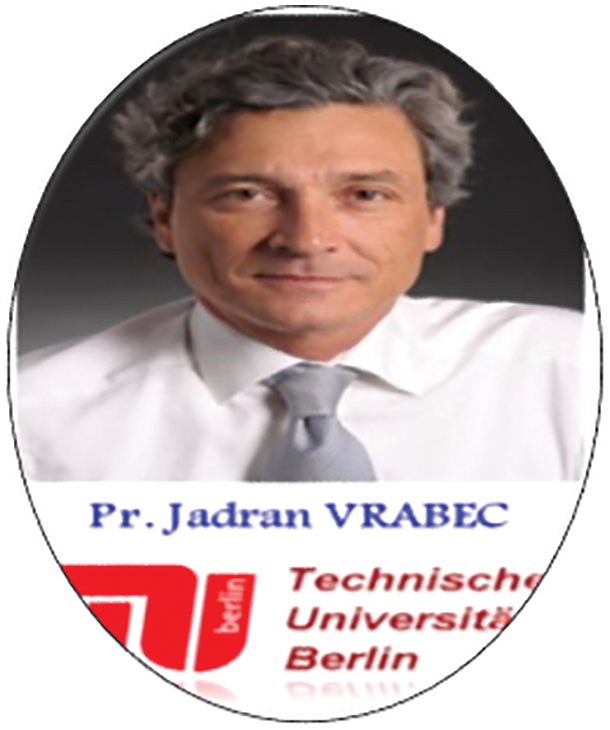
Topic: Atomistic Molecular Modelling and Simulation for Prediction Transport Diffusion Coefficients of Liquid Mixtures.
By: Prof. Jadran Vrabec, Technical University of Berlin, Germany.
Chair of Thermodynamics & Process Engineering, Technical University of Berlin, Germany.
Liquids appearing in nature and industrial applications are essentially multi-component. However, only data on binary diffusion coefficients are relatively abundant because higher-order mixtures are significantly more complex. Molecular modeling and simulation offer a promising route for predicting transport diffusion coefficients and for understanding the underlying phenomena on a microscopic basis. Equilibrium molecular dynamics simulations and the Green-Kubo formalism can be used to predict Onsager and Maxwell-Stefan diffusion coefficients. Subsequently, the thermodynamic factor has to be used to transform these data to Fick diffusion coefficients. An overview of the process, from devising molecular interaction models employing quantum chemical data to predicting Fick diffusion coefficients of multi-component liquid mixtures by atomistic means, is given.
Prof. Jadran Vrabec: Full Professor for Thermodynamics and Process Engineering at the Technical University of Berlin, Germany since 2018. His work is situated around molecular modeling and simulation for process and energy engineering applications. After studying process engineering at the Ruhr-University of Bochum, he also accepted his Ph.D. there in 1996. After an interim phase working as a management consultant, he became a group leader for molecular thermodynamics at the University of Stuttgart, where he received his habilitation in 2007. Between 2009 and 2018, he was full Thermodynamics and Energy Technology professor at the University of Paderborn, Germany. Vrabec has co-authored about 200 peer-reviewed research papers, most of which discuss different aspects of atomistic molecular modeling and simulation methods. He has a strong interest in high-performance computing and developing simulation software. He carried out molecular dynamics simulations with his co-authors for the largest system described on the atomistic scale. Vrabec is active in different German and European working parties for thermodynamics and molecular simulation.
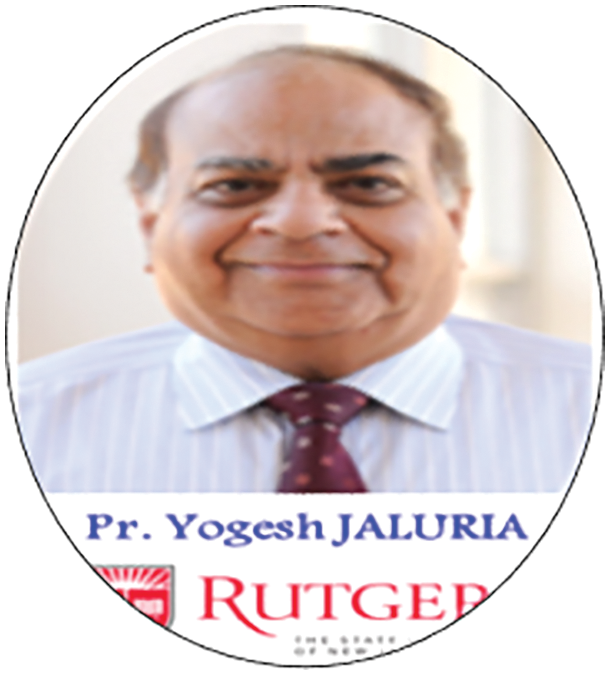
Topic: Chemical Vapor Deposition for the Fabrication of Thin Films in Advanced Materials Processing.
By: Prof. Yogesh Jaluria, Rutgers, the State University of New Jersey, USA.
Many materials, such as gallium nitride, aluminum nitride, and indium gallium nitride, are of interest in applications like power electronics, photovoltaic cells, and light-emitting diodes. High-quality, high-performance, thin films of these materials are often obtained by Chemical Vapor Deposition (CVD), which involves precursors that react and deposit on a wafer or substrate. The quality of the film and the deposition rate are largely determined by the transport processes that arise in the reactor. This presentation discusses the fundamental considerations that may be used to accurately model and simulate these systems. Validation of the model is achieved by comparing it with experimental results. Different flow regimes arise, with different analyses and experimentation being needed at different scales. The simulation is employed to determine the quality of the thin film produced, process efficiency, and optimal conditions. High productivity, minimal loss of precursor gases, and high film thickness uniformity. These results are valuable in practical CVD processes for materials of interest in power devices, LEDs, and solar energy.
Prof. Yogesh Jaluria: Board of Governors Professor and Distinguished Professor at Rutgers, the State University of New Jersey. His research work is in the field of thermal science and engineering. He is the author/co-author of ten books and has contributed over 500 technical articles, including 219 in archival journals and 18 book chapters. He has received several awards and honors for his work, such as the prestigious 2007 Kern Award from AIChE, the 2003 Robert Henry Thurston Lecture Award from ASME, and the 2002 Max Jakob Memorial Award, the highest international recognition in heat transfer from ASME and the AIChE. He has served as Department Chairman and as Dean of Engineering. He was the Editor of the Journal of Heat Transfer (2005–2010) and Computational Mechanics (2003–2005). He is an Honorary Member of ASME and a Fellow of AAAS and APS. He was the Founding President of the American Society of Thermal and Fluids Engineers (ASTFE) and served from 2014 to 2019.
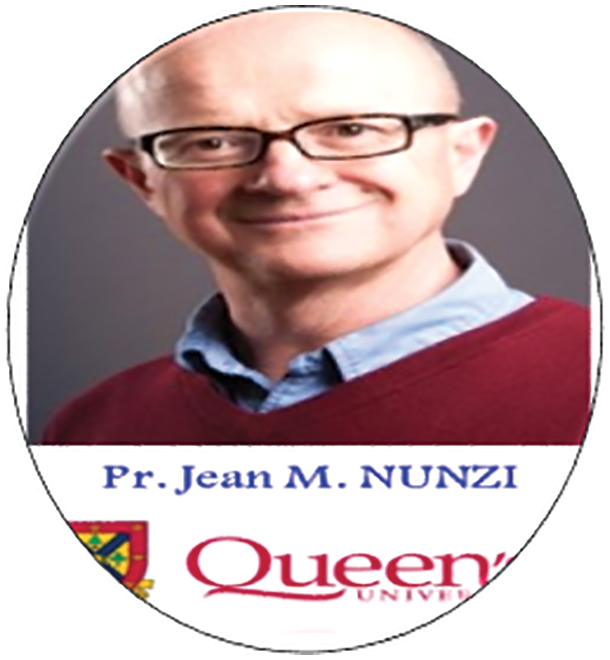
Topic: Photonics for Life.
By: Prof. Jean-Michel NUNZI, Queen’s University, Canada.
Canada Research Chair, Queen’s University, Canada.
Technology was often a drive for scientific development. However, besides what science can do for technologies, several questions remain quite open, like do evolution, intelligence, and the origins of life belong to what Physics can deal with? How may this happen? Self-organization naturally provides materials that can manipulate light and light-matter interactions to build of new nano-photonic devices. With that inspiration, we show how light can naturally induce chiral structures, or help us design new light-harvesting devices like near-IR photodetector using the rectification effect induced by dipole orientation in a thin film. ‘New’ materials like two-dimensional transition metal di-chalcogenides also provide an interesting route to highly efficient light-matter interaction processes. We currently design device structures that allow the fabrication of hot electron-based photodetectors, which are highly sensitive to the NIR range, sensitive to polarization, and easy and cost-effective to fabricate. They are highly demanded devices for machine vision and recognition. In a preliminary step towards what we dream of to achieve global cooling; we also extend our approach to self-organizing structures that permit radiation control from buildings and structures to provide passive cooling or heating solutions under zero energy consumption.
Prof. Jean-Michel Nunzi:Graduatedfrom l’Ecole de Physique et Chime, Paris in 1982. He joined l’EcolePolytechnique for a Ph.D. on the nonlinear optics of surface plasma waves (plasmons). He was then hired as a full-time researcher in Organic Photonics at the Atomic Energy Commission (Saclay) in 1984. He joined the Department of Physics at the University of Angers as Professor in 2000, where he built the Plastic Solar Cells Technology Research Team. He moved to Queen’s University as Tier 1 Canada Research Chair in Chiral Photonics in 2006 and in Photonics for Life Since 2013. He studies Self-organization, Organic, and Nano-Photonics, including the Chemistry, Instrumentation, Processing, and Physics of nanomaterials and devices as well as their use for energy and sustainable development. His Google H-Factor is 53.
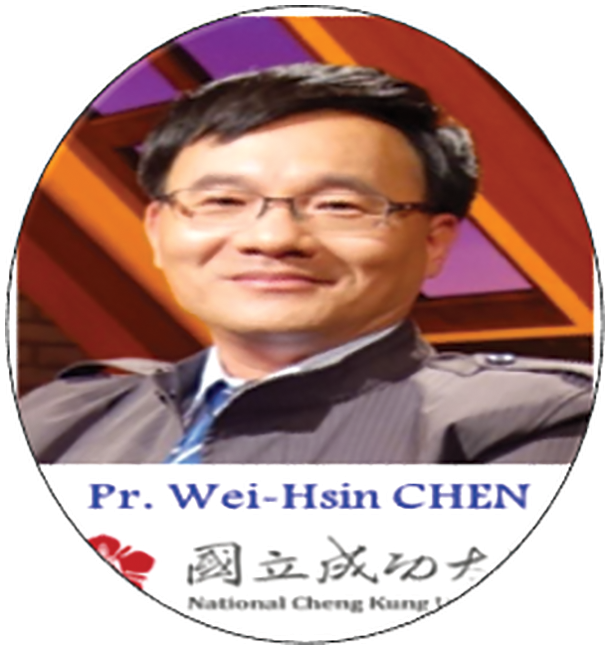
Topic: Advances in Torrefaction Technology for Green Fuel and Energy.
By: Prof. Wei-Hsin Chen, National Cheng Kung University, Taiwan.
Department of Aeronautics and Astronautics, National Cheng Kung University, Taiwan.
The development of green fuel and energy technologies has attracted great attention in that it can lessen fossil (nonrenewable) fuel consumption, abate greenhouse gas emissions, and mitigate global warming and climate change for resource and environmental sustainability. Torrefaction is a promising thermochemical conversion process to pretreat and upgrade biomass for its further utilization. After undergoing torrefaction, the disadvantages of biomass such as its hygroscopic and biodegradable nature, high moisture content, low calorific value, poor grindability, large volume or low bulk density, and low homogeneity for industrial usage can be solved, making biochar approach coal. As a result, torrefied biomass can be used as an alternative to coal consumed in the industry. This study addresses the advances in biomass torrefaction technology to produce biochar for green fuel and energy. The applications of torrefied biomass in the industry such as combustion, gasification, ironmaking, pyrolysis, and liquefaction, are also underlined.
Prof. Wei-Hsin Chen: Distinguished Professor at the Department of Aeronautics and Astronautics, National Cheng Kung University, Taiwan. He visited Princeton University, USA (2004-2005), the University of New South Wales, Australia (2007), the University of Edinburg, UK (2009), the University of British Columbia, Canada (2012 & 2013), and the University of Lorraine, France (2017 & 2018) as a visiting professor. He was also an invited lecturer at the University of Lorraine (2019 & 2020). His research interests include bioenergy, hydrogen energy, clean energy, carbon utilization, etc. He has published around 450 papers in international and domestic journals and conferences. He is the associated editor of the International Journal of Energy Research, and the editorial member of some international journals, including Applied Energy, Energies, Energy, Ecology and Environment, etc. He is also the author of several books concerning energy science and air pollution. Recently, his important awards include 2015 and 2018 Outstanding Research Awards (Ministry of Science and Technology, Taiwan), 2015 Highly Cited Paper Award (Applied Energy, Elsevier), 2017 Outstanding Engineering Professor Award (Chinese Institute of Engineers), 2019 Bioresource Technology Award for Highly Cited Review Article, and 2016, 2017, 2018, and 2019 Web of Science Highly Cited Researcher Awards.
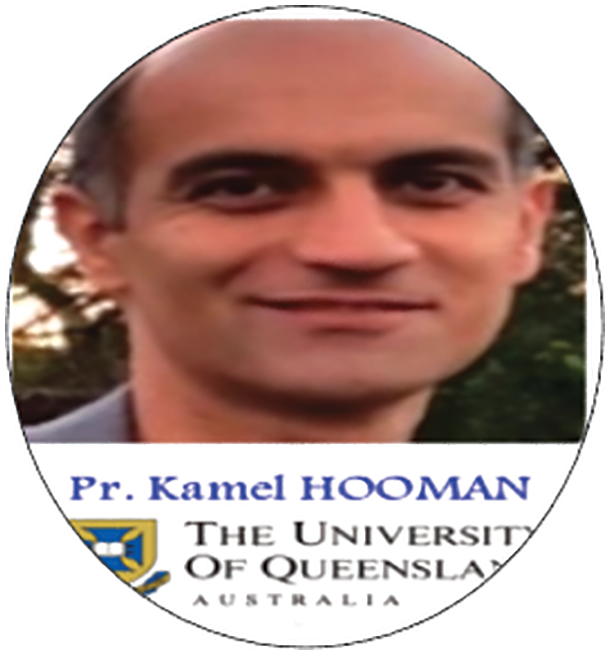
Topic: Increasing the Capacity Factor of Concentrated Solar Thermal Power Plants.
By: Prof. Kamel Hooman, Queensland University, Australia.
School of Mechanical & Mining Engineering, Queensland University, Australia.
Though the Levelized cost of electricity (LCoE) of a PV plant is currently lower than that of a concentrated solar thermal (CST) plant, the latter offers the possibility of higher capacity factors at lower costs. This is mainly because electricity storage in batteries is more expensive than thermal energy storage per kW basis. Hence, thermal energy storage plays a key role in development of CST. The choice of thermal energy storage depends on the thermodynamics cycle temperatures. Proper choice of thermal energy storage, based on a techno-economic analysis conducted for a CST plant in Australia, will be discussed. The selected system is then optimized, aiming at shortening the charge/discharge period, using a combination of numerical, experimental and theoretical techniques, the results of which will be presented and discussed.
Prof. Kamel Hooman:Dr. Hooman has over two decades of work experience in industry and academia. His research focuses on thermofluids engineering, with particular attention to energy conversion, using numerical, theoretical, and experimental techniques. He is an Associate Editor for the Journal of Porous Media, Heat Transfer Engineering, and International Journal of Heat and Mass Transfer. He serves on many Editorial Boards and has acted as Guest Editor for some journals, with Applied Thermal Engineering and ASME Journal of Fluids Engineering being the latest ones. He has received awards and fellowships from the Emerald, Australian Research Council, Australian Academy of Science, National Science Foundation China, and Chinese Academy of Sciences. With over 150 journal papers and some book chapters, he has also presented as Keynote/Plenary in numerous conferences and meetings. While a full-time academic staff at the University of Queensland, Dr. Hooman has held visiting professor positions in Europe and Asia. He has co-authored a book “Convection Heat Transfer in Porous Media,” which was published in November 2019.
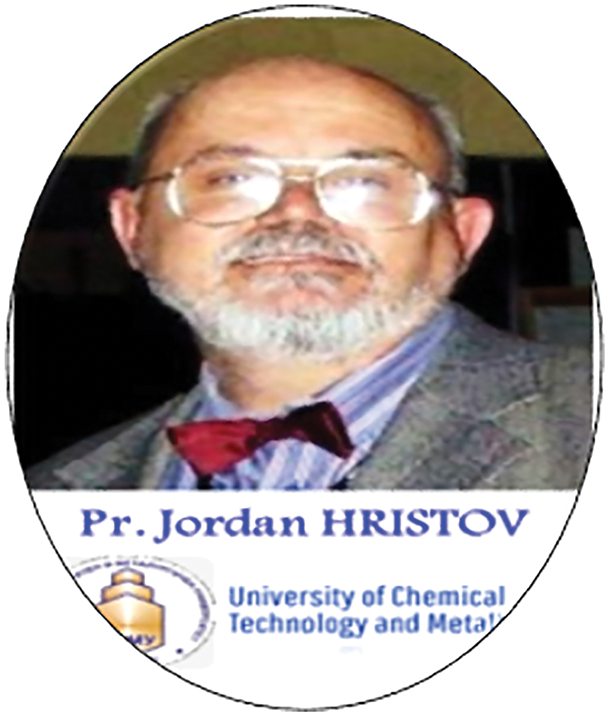
Topic: Nonlocal Effects in Materials and Memory Formalism in Modelling Physical Properties and Heat-Mass Transfer.
By: Prof. Jordan Hristov, Department of Chemical Engineering,
University of Chemical Technology and Metallurgy, Bulgaria.
The lecture presents the nonlocal effect in modeling material properties, such local defects and changes in material properties (Density, Heat Conductivity or Diffusivity), their physical basis and the memory formalism applied in mathematical modeling. Precisely, problems concerning the principle of aerodynamics in material non-homogeneity modeling and the finite speeds of heat and mass adequately modeled by time and space fractional operators are at issue.
Prof. Jordan Hristov: Professor of Chemical Engineering at the University of Chemical Technology and Metallurgy, Sofia, Bulgaria. He graduated in 1979 as Electrical Engineer (MS equivalent) at the Technical University, Sofia, Bulgaria. His Ph.D. thesis on the magnetically assisted fluidization was awarded by the University of Chemical Technology and Metallurgy in 1995. His Doctor of Science Thesis on non-linear and non-local diffusion models was awarded in 2018. Prof. Hristov’s research interests cover the areas of particulate solids mechanics, fluidisation, heat and mass transfer with special emphasis on scaling and approximate solutions of nonlinear problems. His recent direction in mathematical modeling is the nonlocality in transport phenomena, emphasizing the application of fractional calculus.

Topic: Development of a Mechanistic Model to Predict the Influence of Gravity on Higher Plant Growth.
By: Prof. Jean-Pierre Fontaine, Clermont Auvergne University, France.
Long-duration human space missions will need to develop an efficient life-support system to recycle atmosphere, water, and waste for the crew’s survival. The European Space Agency MELiSSA project (Micro-Ecological Life Support System Alternative) mimics a lake ecosystem. It consists of a closed-loop bio-regenerative system based on microorganisms and higher plants and provides circular mass cycling, including O2 production, CO2 capture, water recycling, and food production. As the growth and development of higher plants are strongly influenced by environmental conditions (g, p, T, RH, partial pressure of O2 or CO2), bio-regenerative life support systems require a high level of control and management. This study aims to develop a mechanistic model to predict the effects of microgravity or a reduced gravity environment on plant growth at its morphological, physicochemical, and biochemical levels. Current agronomy plant growth models are not adapted for growth in controlled environments and do not provide a better understanding of physical growth mechanisms. Thus, a mechanical plant growth model has been under development for the MELiSSA project for a few years. This study describes the addition of gravity as a parameter, considering of the altered gas exchanges in low-g environments. The influence of convection intensity was investigated for several gravity levels. A recent use of parabolic flights on a specifically designed set-up, has attempted to quantify plant gas exchange at the leaf level under forced convection based on IR measurements.
Prof. Jean-Pierre Fontaine: Professor in chemical engineering at the University Clermont Auvergne (Clermont-Ferrand, France) since 2003. Beforehand, he worked for 08 years in industry (R&D Center in Sophia Antipolis, France), 02 years at the University of Colorado (Boulder, Colorado, USA), and 05 years at Aix-Marseille University (France), where he obtained his Ph.D. in Fluid Dynamics in 1990. His research activities have focused on the modeling of complex multi-physics transport phenomena (fluid, heat and mass transfer) in different domains. The main topics concern crystal growth, humidity sensing, condensation transfer on the heterogeneous surface, interfacial phenomena, reduced gravity environments, dye-sensitized solar cells, hydrodynamics of bioreactors in order to optimize mixing and biological reactions, and the influence of gravity on higher plant growth. He has authored more than 60 peer-reviewed publications, European patents, and has contributed to about 80 conferences.
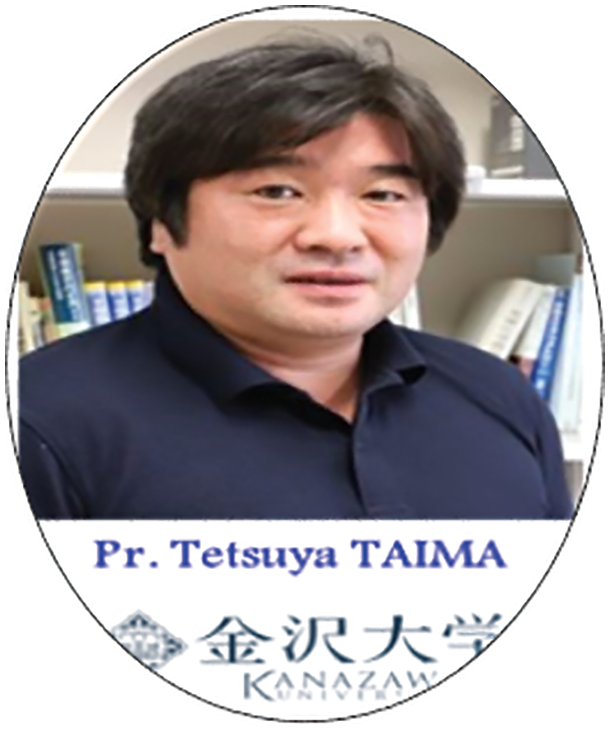
Topic: Efficiency Improvement of Organic Photovoltaic Cells by Nano-Structure and Molecular Orientation Controls.
By: Prof. Tetsuya Taima, Kanazawa University, Japan.
Nanomaterials Research Institute (NanoMaRi), Kanazawa University, Japan.
A bulk heterojunction (BHJ) structure by co-evaporation of organic photovoltaics (OPVs) provides the large donor-acceptor interface, which facilitates efficient charge separation. However, it is difficult to control directly the morphology of the co-evaporated BHJ layer because of the random blend of donor and acceptor molecules. Many efforts have been made for structure control of BHJ layer by introducing a new substitute in the molecule and combining additive molecules in solution. Recently, we reported highly efficient OPV cells by inserting CuI molecular orientation control layer under the zinc phthalocyanine (ZnPc): C60 co-evaporated BHJ layer. It is estimated that higher light absorption coefficient was obtained by controlled ZnPc lying-down molecular orientation due to π-d interaction between ZnPc and CuI. However, various measurements have not obtained information on the ZnPc molecular orientation in ZnPc: C60 film, such as XRD, XAFS, and TEM, due to its low crystallinity in ZnPc: C60 film. Hence, we report the identification of molecular orientation in ZnPc: C60 film by Infrared reflection absorption spectroscopy (IR-RAS), which is enabled to measure the molecular orientation in amorphous film. We successfully calculated the molecular orientation angle in co-evaporated films on various substrates by IR-RAS.
Prof. Tetsuya Taima: Professor at Nanomaterials Research Institute (NanoMaRi), Kanazawa University, Japan, since 2018–2002: Doctor Degree. Department of Applied Chemistry, School of Engineering, Tohoku University. 2002–2004: Post-Doctoral Researcher (JSPS Research Fellowship). National Institute of Advanced Industrial Science and Technology (AIST). 2005–2011: Research Scientist. Permanent Researcher at Research Center for Photovoltaics (RCPV), AIST. 2009–2015: PRESTO Researcher (Concurrent Post). Project Member of Precursory Research for Embryonic Science and Technology (PRESTO) at Japan Science and Technology Agency (JST) is the Award to Excellent Researchers. 2012–2015: Associate Professor (Tenure Track). RSET, Kanazawa University. 2015–2017: Associate Professor/Unit leader (Tenure Track). InFiniti, Kanazawa University. 2017–2018: Professor/Unit Leader. InFiniti, Kanazawa University.
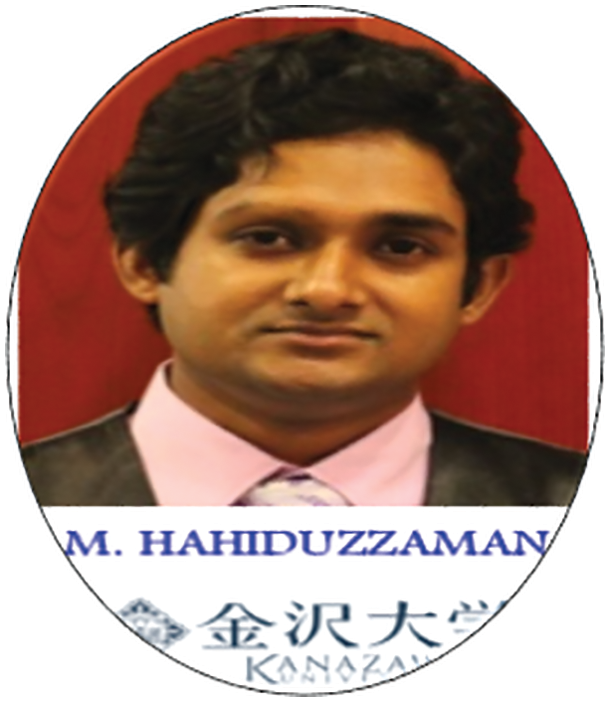
Dr. Md. Shahiduzzaman: Assistant Professor at the Nanomaterials Research Institute (NanoMaRi), Kanazawa University where he designs, fabricates, and develops highly efficient and stable perovskite solar cells (PSCs) for next-generation solar cells. Born in Bangladesh in 1984, Dr. Shahiduzzaman moved to Japan for postgraduate study in 2011. He obtained a Master’s Degree in Thermoelectric Materials & Application from Japan Advanced Institute Science & Technology (JAIST) in 2013 and did his Ph.D. on PSCs from Kanazawa University in 2016. He was a post-doctoral fellow in Professor Tetsuya Taima’s Group at Kanazawa University. During his tenure (10/2016 until 09/2017) at Kanazawa University, he extensively worked on the improvement of PSCs performance. Then he did another post-doctoral (10/2017 until 10/2018) at Tokai University, Japan under Tokai University General Research Organization fellowship where he worked on the design and fabrication of low-temperature (<180°C)-processed brookite based-TiO2 junctions and test their performance in PSCs. His research interests include integrating micro-and nanotechnology to develop innovative methods to solve energy generation problems. He is also interested in design, fabrication, and development of high-efficiency, stable, green, and flexible solar cells for various energy applications. He published one patent and 26 peer-reviewed articles to the date.
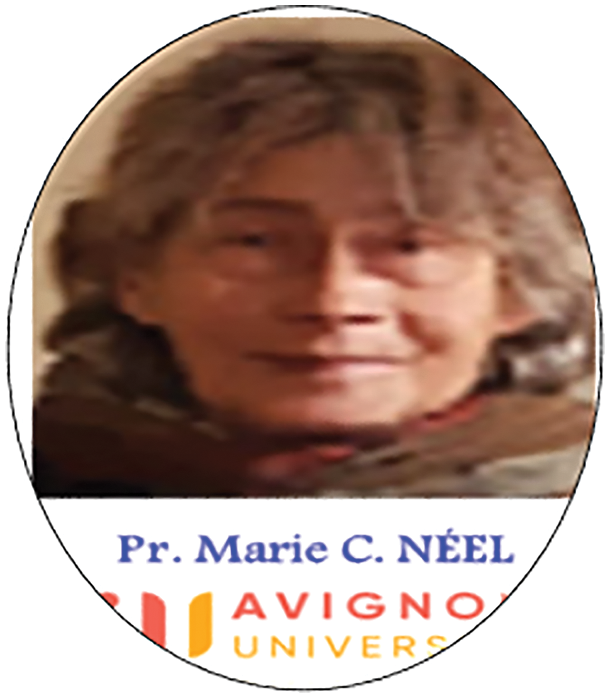
Topic: Experimental and Numerical Study of Geometrically Driven Drop Motion.
By: Prof. Marie-Christine Néel, Avignon University, France.
Some organisms living in arid environment harvest water on their own skin, on which liquid drops move spontaneously in a privileged direction. Here the word «spontaneous» means no pressure difference or an external force is needed. Given copying such motion in the industrial process, we consider it on materials possessing properties like robustness or electric conductivity. Spontaneous directed drop motion on a horizontal flat surface may be caused by heterogeneous wettability whose gradient points toward some specific direction. It also occurs on a flat surface of uniform physico-chemical properties decorated by sequences of identical micrometric obstacles forming like channels. Measuring drop motion on such a device, here made of steel, evidence patterns that promote directed transport. Observed motion is fragmented into successive stages of uneven velocity. Numerical simulation investigates the flow regimes observed during these stages. It also gives us a flexible tool to optimize channel design in order to enhance motion.
Prof. Marie Christine Néel: Professor Emerita at Avignon University, where she has taught mechanics and physics since 1998. Her research covered diverse themes in the field of fluid mechanics, with special attention to liquid flowing through the porous material. She has previously developped theoretical and numerical methods to predict fluid flow instability caused by thermal gradient or magnetic field. She also studied diffusion equations, including derivatives of non-integer order that reveal molecular motion represented by a stochastic process more general than Brownian motion. Considering that Nuclear Magnetic Resonance measures the characteristic increment function of such a process, she is investigating molecular motions on the basis of such data complemented by a tracer test. Marie-Christine Néel is also working on fluid flow in the nonsaturated porous material.
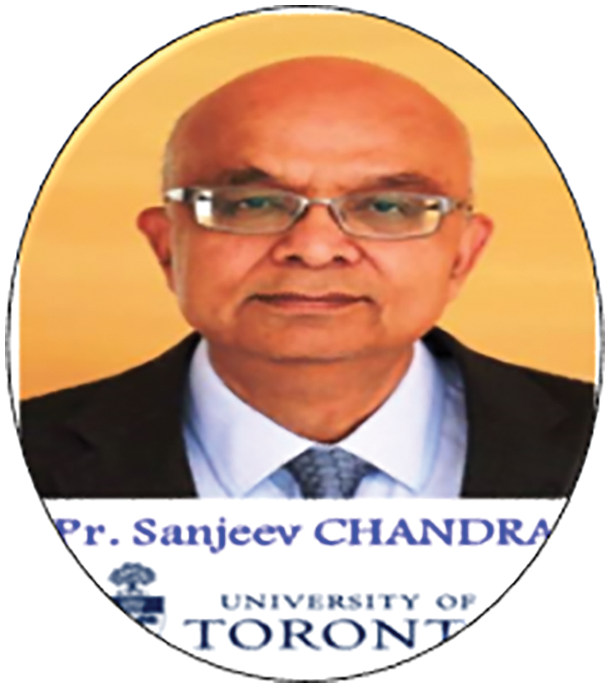
Topic: Spray Forming of Thermal Management Devices.
By: Prof. Sanjeev Chandra, Toronto University, Canada.
Centre for Advanced Coating Technologies, Toronto University, Canada.
Thermal spray is a process in which a coating material (metal, ceramic or polymer) is melted in a high-velocity gas jet and sprayed onto a surface. It is widely used to apply protective coatings but can also be used as an additive manufacturing technique to make devices for thermal management, including heat exchangers, heat sinks, cold plates, and heat pipes. Compact, high-efficiency heat exchangers were made by spraying metal skins on metal foams’ exterior surfaces with a large internal surface area for heat transfer. Composite heat sinks were made by spraying thin metal layers on polymer scaffoldings, producing lightweight devices that use only a minimal amount of metal where required. Heat pipes were made by spraying porous metal layers that acted as wicks for the capillary transport of liquids. Spraying allows coatings to be applied rapidly over a large area, making it feasible to make thermal management devices that are very large in extent.
Prof. Sanjeev Chandra: Professor in the Department of Mechanical and Industrial Engineering at the University of Toronto, which he joined after receiving his Ph.D. from Cornell University in 1990. Prof. Chandra is known internationally for his research on the dynamics of droplets and sprays and is one of the founders of the Centre for Advanced Coating Technologies at the University of Toronto. His research spans the areas of fluid mechanics, heat transfer, and materials science and has also been applied in spray coating, spray cooling, spray painting, ink-jet printing, electronic cooling, and waste heat recovery. Prof. Chandra has published over 250 papers in referred journals and international conference proceedings. He has written an undergraduate textbook on thermodynamics and several chapters for books on the subjects of thermal spray coating, heat transfer, and sprays. In 2010 he was awarded the The Brockhouse Canada Prize for Interdisciplinary Research, awarded by the Natural Sciences and Engineering Research Council of Canada to recognize outstanding collaborative research. In 2015 he was awarded the Jules Stachiewicz Medal by the Canadian Society for Mechanical Engineering for outstanding contributions to heat transfer.
Topic:Ordered and Disordered Tannin-Derived Carbons as Supercapacitor Electrodes.
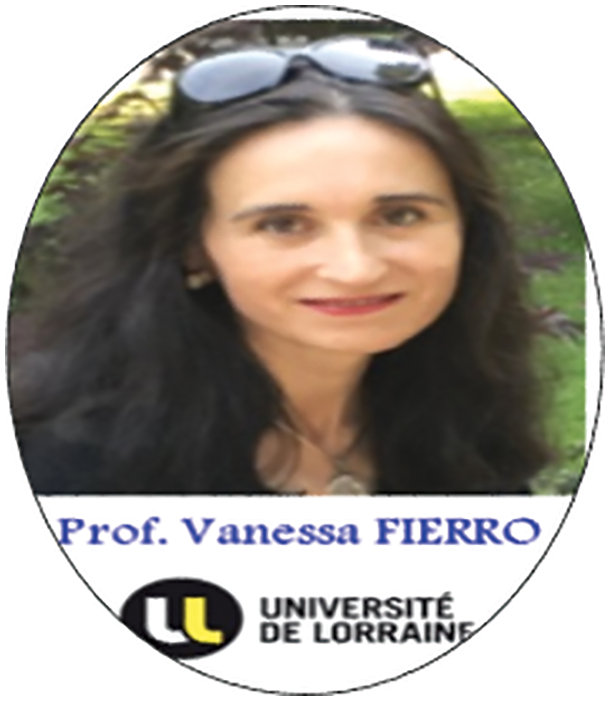
By: Dr. Vanessa Fierro.
CNRS Research Director, Institut Jean Lamour, CNRS/Lorraine University, France.
Soft-templating can produce disordered and perfectly ordered mesoporous carbons (DMC and OMC, respectively). An eco-friendly and easy synthesis method, by surfactant-water, assisted mechanochemical mesostructuration of Mimosa tannin around the amphiphilic surfactant Pluronic F127© was used for the first time. It is an easy and fast, one-pot method, only requiring one h of ball-milling without any additional drying or curing step before carbonization. Furthermore, the method is environment-friendly due to the use of a natural and renewable carbon precursor and the absence of toxic or hazardous substances during the synthesis. After carbonization at 900°C, carbons with moderate BET area (ABET), around 600 m2/g, were obtained and used for different applications. CO2 activation, which was more efficient in DMC, allowed obtaining materials with a more refined pore texture, ABET ~2000 m2/g. When these materials were used as electrodes of supercapacitors, they exhibited high capacitance values together with high specific energy and power. We will discuss the effect of pore connectivity on these performances, and we will present the last strategies to improve the characterization of nanoporous materials.
Prof. Pr. Vanessa Fierro: A CNRS Research Director presently working at Institut Jean Lamour (IJL). She pursued doctoral research at the Institute of Carbochemistry (ICB-CSIC) and obtained her Ph.D. from Zaragoza University (Spain) in 1998. She has been working for several years as a researcher at the French Institute of Petroleum, at the Institute of Research on Catalysis and the Environment of Lyon (France) then at the Chemical Engineering School of Tarragona (Spain). She entered CNRS in 2006 and joined IJL in 2009, where she is now leading the Bio sourced Materials Research Team since 2018. Vanessa is a member of the Coal Technical Group 1 (TGK1) member of the Research Fund for Coal and Steel (RFCS). She has more than 300 scientific publications, has an h-index of 51 and an extensive background in porous carbon materials for energy and environmental applications. Her current research interests focus on developing materials from biosourced precursors able to substitute those of petrochemical origin.
Topic:Growth of Semiconductor Single Crystals for Energy Conversion.
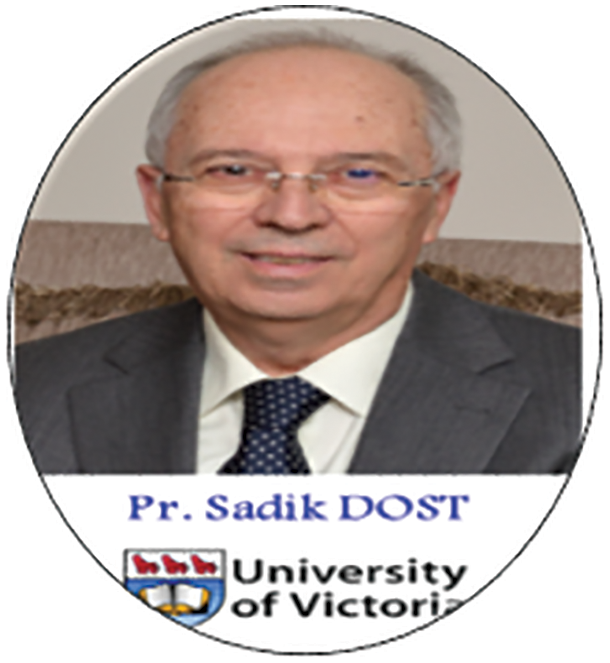
By: Prof. Sadik Dost, University of Victoria, Canada.
Department of Mechanical Engineering, Crystal Growth Laboratory, University of Victoria, Victoria, BC, Canada.
Single crystal and polycrystalline semiconducting materials of silicon (Si), germanium (Ge), cadmium zinc telluride (CdZnTe) and gallium antimonide (GaSb) have been used for energy conversion in the visible and infrared spectrum. The talk will overview the single crystal growth of GaSb, CdZnTe, and Silicon-Germanium (SiGe) from metallic solutions and melt. The growth techniques used at the University of Victoria are the solution growth techniques of the Travelling Heather Method (THM) for GaSb and CdTe, Liquid Phase Diffusion (LPD) for SiGe, and the melt growth method of Vertical Gradient Freezing (VGF) for CdZnTe. The progress and the remaining issues of these growth processes will be discussed. Recent Experimental and numerical simulation results will be presented.
Prof. Sadik Dost: Professor and Director of the Crystal Growth Laboratory at the University of Victoria since 1989. He graduated from Karadeniz Technical University of Turkey in 1969 and obtained his Ph.D. at Istanbul Technical University in 1974. He has then worked as a faculty member at Ege University of Turkey until 1980 and then at the University of Calgary until 1989. He is the founding director of a university research center: CAMTEC (Centre for Advanced Materials and Related Technology) at UVic, and served as its Director from 1992 to 1997. He also served as Chair of the Department of Mechanical Engineering at UVic from 1997 to 2003. Dr. Dost has been a Canada Research Chair in Crystal Growth from 2003 to 2017. His research combines an experimental and theoretical study of the growth of bulk single crystals from melt and solution using a variety of crystal growth processes such as Bridgman (B), Vertical Gradient Freezing (VGF), Liquid Phase Electroepitaxy (LPEE), Liquid Phase Epitaxy (LPE), Travelling Heater Method (THM), Liquid Phase Diffusion (LPD), Float-Zone (FZ), and Top-Seeded Solution Growth (TSSG). He has made significant contributions to these techniques.
The Averroes Award
The Averroes prize (Fig. 3) was introduced in 2015 to distinguish scientists or actors in science who have worked for the training of young scientists and contributed significantly to the scientific impact on society.

Figure 3: Ibn Rochd of Cordoba (Arabic pronunciation), better known in the Western country by his Latinized name of Averroes, is a 12th-century Arabic-speaking Andalusian Muslim philosopher, theologian, jurist and physician, born April 14, 1126 in Cordoba in Andalusia and died on December 10, 1198 in Marrakech, Morocco
An Averroes committee composed of winners and members is in charge of selecting and awarding the prize.
The 2021 edition awarded Professor Geoffrey Levermore for his significant contribution to science interlink and climate change (Fig. 4).

Figure 4: ICOME 2021–Averroes Award to Prof. G. Levermore GIEC Member and Co-Laureates of the Nobel Prize 2007 in the middle between ICOME Chairs Prof. Bennacer (at right) and Prof. El Ganaoui
Symposia during ICOME 2021
The conference hosted three important symposia on actual subject for high experimentation and accurate simulation occasioning a round rabbit discussion, namely
• Photonics for Energy by Hassina Derbal, J. M. Nunzi.
• Innovative Lattice Boltzmann for Complex Simulations by R. Bennacer M. El ganaoui, S. Houat, K. Ragui, M. Tekitek.
• Microgravity Fundamental and Applications by R. Bennacer, P. Bontoux, M. El Ganaoui, J. Ouazzani, J. P. Fontaine, M. Lappa.
1CHT Computational Heat Transfer (G.D. Davis et al.)–CFM Congrès Français de Mécanique (M. Combarnous et al.)–ICCMT Int. Conf. Comp. Heat and Mass Transfer (A.A. Mohamad et al.)–ICTEA (Z. Saghir et al.)–JITH Journée Int. de Thermique (R. Martin et al.)–ICCREMA Renewable Ener Mat. Applications (H. Sammouda et al.).
Acknowledgement: Authors acknowledge the University of Lorraine, Metz City and Metz Metropole for organizing the topical school in Metz 2 December 2021.
Funding Statement: The authors received no specific funding for this study.
Conflicts of Interest: The authors declare that they have no conflicts of interest to report regarding the present study.
Appendix
1. M. El Ganaoui, R. Bennacer, P. Mutzenhardt, O. Fassi-Fehri, D. Karem. “Opening Ceremony of ICOME 21”.
2. Geoffrey Levermore. “Climate Change and Materials for Mitigation and Adaptation”.
3. Jadran Vrabec. “Atomistic Molecular Modelling and Simulation for Prediction Transport Diffusion Coefficients of Liquid Mixtures”.
4. Yogesh Jaluria. “Chemical Vapor Deposition for the Fabrication of Thin Films in Advanced Materials Processing”.
5. Jean-Michel Nunzi. “Photonics for Life”.
6. Wei-Hsin Chen. “Advances in Torrefaction Technology for Green Fuel and Energy”.
7. Kamel Hooman. “Increasing the Capacity Factor of Concentrated Solar Thermal Power Plants”.
8. Jordan Hristov. “Nonlocal Effects in Materials and Memory Formalism in Modelling Physical Properties and Heat-Mass Transfer”.
9. Marie-Christine Néel. “Experimental and Numerical Study of Geometrically Driven Drop Motion”.
10. Jean-Pierre Fontaine. “Development of a Mechanistic Model to Predict the Influence of Gravity on Higher Plant Growth”.
11. Tetsuya Taima, Md. Shahiduzzaman. “Efficiency Improvement of Organic Photovoltaic Cells by Nano-Structure and Molecular Orientation Controls”.
12. Sanjeev Chandra. “Spray Forming of Thermal Management Devices”.
13. Vanessa Fierro. “Ordered and Disordered Tannin-Derived Carbons as Supercapacitor Electrodes”.
14. Sadik Dost. “Growth of Semiconductor Single Crystals for Energy Conversion”.
Cite This Article
 Copyright © 2023 The Author(s). Published by Tech Science Press.
Copyright © 2023 The Author(s). Published by Tech Science Press.This work is licensed under a Creative Commons Attribution 4.0 International License , which permits unrestricted use, distribution, and reproduction in any medium, provided the original work is properly cited.


 Submit a Paper
Submit a Paper Propose a Special lssue
Propose a Special lssue View Full Text
View Full Text Download PDF
Download PDF Downloads
Downloads
 Citation Tools
Citation Tools